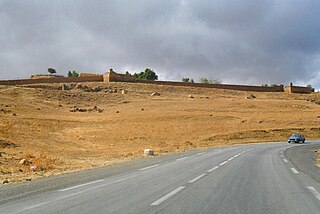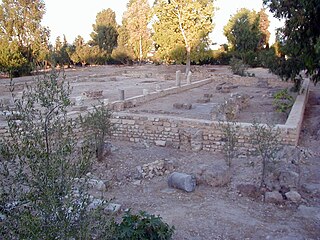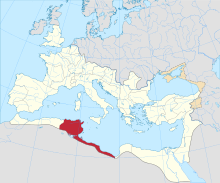Ruspe or Ruspae was a town in the Roman province of Byzacena, in Africa propria. It served as the episcopal see of Saint Fulgentius of Ruspe. It is now a Roman Catholic titular bishopric.

Boghar is a town and commune in Médéa Province, Algeria.

Avitta Bibba was a town in the Roman province of Africa Proconsularis. The town is tentatively identified with ruins at Henchir-Bour-Aouitta in Tunisia.

The Archdiocese of Carthage, also known as the Church of Carthage, was a Latin Catholic diocese established in Carthage, Roman Empire, in the 2nd century. Agrippin was the first named bishop, around 230 AD. The temporal importance of the city of Carthage in the Roman Empire had previously been restored by Julius Caesar and Augustus. When Christianity became firmly established around the Roman province of Africa Proconsulare, Carthage became its natural ecclesiastical seat. Carthage subsequently exercised informal primacy as an archdiocese, being the most important center of Christianity in the whole of Roman Africa, corresponding to most of today's Mediterranean coast and inland of Northern Africa. As such, it enjoyed honorary title of patriarch as well as primate of Africa: Pope Leo I confirmed the primacy of the bishop of Carthage in 446: "Indeed, after the Roman Bishop, the leading Bishop and metropolitan for all Africa is the Bishop of Carthage."

Aeliae or Æliæ was a Roman-era city in the province of Byzacena.
Ausafa or Uzappa was a Roman era town, in the Roman province of Africa Proconsularis and in late antiquity Byzacena.
Bouderies is a settlement in Kasserine, Tunisia, in North Africa.

Cubda was an ancient city in Tunisia. It is a titular bishopric of the Roman Catholic Church.
Botriana is a locality and archaeological site in Tunisia
Henchir-Baldia is an archaeological site and locality in southern Tunisia. The stone ruins are tentatively associated with Bladia, a civitas of the Roman province of Byzacena during the Roman Empire. It was a Catholic bishopric.

Autenti was a Roman–Berber civitas and bishopric in Africa Proconsularis. It was a diocese of the Roman Catholic Church.

The Diocese of Bennefa is a home suppressed and titular see of the Roman Catholic Church. Bennefa, identifiable with Oglet-Khefifa in modern Tunisia, is an ancient civitas of the Roman province of Byzacena. and a seat of an ancient Christian episcopal see. The diocese was mentioned by Augustine of Hippo.

Edistiana was an ancient Roman–Berber city in the province of Africa Proconsularis and in late antiquity of Byzacena. It was located in the modern Tunisia. It was a former Catholic diocese.

Muzuca was a Roman Town of the Roman province of Byzacena during late antiquity. The town has tentatively been identified with the ruins at Henchir-Besra in modern Tunisia. Very little is known of the city, though in situ epigraphical evidence gives us the name and that in late antiquity it achieved the status of Municipium.
The diocese of Benepota is a suppressed and titular see of the Roman Catholic Church.
The diocese of Bacanaria is a suppressed and titular see of the Roman Catholic Church.
Belesasa was an ancient city and former bishopric in Roman North Africa, which only remains a Latin Catholic titular see.
The diocese of Betagbarar is a suppressed and now titular see of the Roman Catholic Church.

The Diocese of Zella is a suppressed and titular see of the Roman Catholic Church.

The diocese of Dionysiana is a suppressed and titular see of the Roman Catholic Church.



